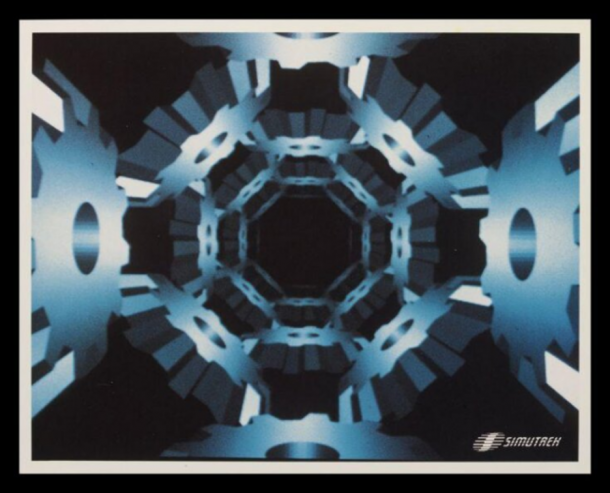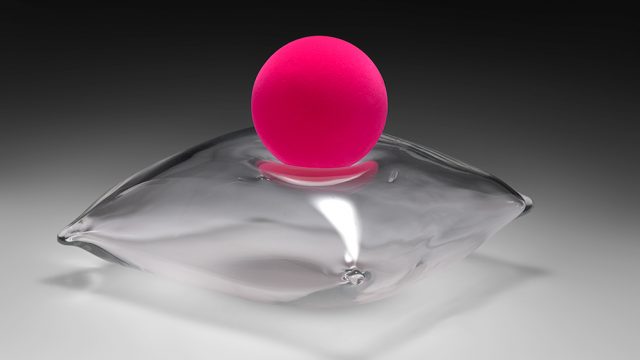For the display Patric Prince: Digital Art Visionary, I completed research on the collection and archive of this fascinating collector and curator. A defining feature of her collecting was how broad it was – not bound by time, subject matter, technique, or technology – if it was experimental and made by a computer, she was interested. As a result, her collection has many works that others did not consider important at the time – like print-outs not designed for display, or exhibition invites. Today, they provide a unique insight into early computer and digital art practices.
The collection also contains works that used or developed innovative computer animation technology. One such example is from the videogame Cube Quest, developed by a team led by the programmer Paul Allen Newell. Prince collected two stills from the game (E.985-2008 and E.986-2008), which are now held in the V&A collection.

Cube Quest is an arcade game, where the player navigates a spaceship through different environments (which are structured as a cube – giving the game its name). The goal is to reach the treasure at the far end of the cube, which requires shooting enemies on the way. While it was not a huge commercial success – and Paul himself regrets that it was not possible to spend more time working on the game play – it is celebrated in the gaming community. This is largely because of the leaps forward in computer graphics that it incorporated.
During my research for the display, Paul was kind enough to speak to me to about how he and his team developed the game. Just 40-years later, sophisticated rendering software is widely available, making it hard to imagine the challenges faced and the innovation needed to push forward the technology. Below are excerpts from this conversation, where Paul shared how he found his way into game design and the complex process of making the game.

Livia Turnbull: I’m interested in how you got into game design in the first place? It’s obviously a field that still needs a lot of skill today, but back in the 1970s I imagine it was really hard to access that kind of training.
Paul Allen Newell: Back in 1970 I was a graduate student in film and video at UCLA. I was doing experimental video with Shirley Clarke, and computer animation with John Whitney.
LT: What kind of equipment were you working with at that time?
PAN: The amount of equipment UCLA had for doing computer animation was almost non-existent. The film school’s animation department didn’t include computers and the Art Department only had a Tektronix 4051. It convinced me that I needed to go and find somewhere that had the facilities that I needed. Somehow or another – I can’t remember the exact way it happened – I ended up with an invite out to NASA’s Jet Propulsion Lab where Bob [Robert] Holtzman was leading the computer graphics lab. I convinced him to let me use his equipment there.
David Em was working there at the time as the official artist in residence – so the joke was that I was the unofficial artist in residence. I wasn’t allowed there during the day – but at night when everybody was gone, I had free use of all the equipment. At the time, Jim Blinn was working on the Voyager missions to Saturn and Jupiter.
LT: And you were still studying at the time?
PAN: Yes, I got my MFA – rumour had it that it was the first computer animation film that was awarded an MFA at UCLA. The problem with it is that nobody can verify it because the professor of animation did not believe in computers and did not think it worth acknowledging.
LT: Can you tell me about that pivot to games?
PAN: I needed a job once out of graduate school and answered an ad for videogame programmers. This was a new domain so pretty much just having experience computer programming to make images/movies/interaction was enough to be considered. I got the job and started June 1981 by programming for the original Atari 2600 VCs, and the Vectrex home units. I loved it! After doing those home game systems, I had the opportunity to do an arcade game.
LT: That was Cube Quest with Simutrek?
PAN: Yes.
LT: Am I right in thinking that was a new company when you joined? Could you tell me a bit about some of the challenges with equipment that your team faced?
PAN: When we formed Simutrek, there was nothing – we showed up in the office on the first day and we had to start from scratch, even inventing our own hardware.
We started by getting permissions from the company that made the Vectrex that I had already programmed a game for so we could use one of their units for development. It was a great start, because it gave me a way to have a display with a system that I already knew how to programme. So I did the first iterations of the game in Vectrex. This allowed me to develop the game on existing hardware while the real arcade hardware was being created.
LT: What was the concept for that game?
PAN: One of the defining features of the game is that the 3×3 cube consists of 54 corridors, it was modeled after a Rubik’s Cube and each of the 9 planes could be rotated clockwise or counter-clockwise. For the game play, you effectively do battle in each corridor and fly down to go to the next. As the game involves surfaces which were a bit like a Rubik’s Cube, it meant it continuously changes where you’re going. Each of the corridors is unique, and we did them in different ways – the majority with computers. There are a couple that are made using traditional animation – an artist sitting down and drawing, like the one in the display.
LT: That’s one of the reasons I was so keen for it to go in the display, rather than the other image in the V&A’s collection, which is computer generated. It captures this moment of shift into new techniques – this game is right at the cusp, combining different techniques.
PAN: The team was doing the background imagery with Robert Abel and Associates. It’s a lot “sexier” than the simple animation. We’re not just branching down paths, we’re using loops so you can play endless corridors – we had our own custom laser disk player that was enabling all this. So it uses a laser disk for the backgrounds, and a line buffer for the graphics, combining those two techniques.
LT: And how did the release go?
PAN: Oh, the game totally failed. Tanked. Blew up!
LT: I think you’re underselling it! Even without commercial success, it was this huge leap forward in graphics, and it’s still celebrated today as an important innovation.
PAN: Well, that’s the thing, technically it was a major increase in what arcade video games could do, up until that point it was either pixels (think Pacman) or you had vector (which Tempest used). That means it’s actually being generated line by line, and that’s the precursor to frame buffers in videogames.
LT: So do you have any ideas about how these images ended up in Prince’s collection? With some of these more modest pieces, it can be a bit of a challenge to trace how she got a hold of them.
PAN: Well, I met Patric through her husband Bob Holtzman, at the time when I was using the equipment at NASA’s Jet Propulsion Lab. When we released the game, we had to go down and show it in New Orleans at the annual arcade show. The company made some promo material, and the two pieces you have in the collection were part of this promo material. Patric got in touch with me to ask for copies at this point – I sent them over to her as a friend.
We actually stayed in touch and ended up working together a little. When she did her 1986 SIGGRAPH art show, I was the one who put together the six-hour video retrospective for her. I was surprised to see that these stills ended up in her collection – and then at the V&A, Patric’s interest was generally more artistic, and this is a purely commercial product.
LT: That’s really interesting to hear – I think her collection is really unique in that a lot of the works have come in through her personal connections to artists.
PAN: She definitely had one-on-one personal relationships with a large number of these artists. Looking back it was really important that she collected and cared for this kind of material.
LT: Paul, thank you so much for taking the time to talk to me.
The ‘Cube Quest’ image discussed in this interview is available to view in the Leighton corridor (Room 102), in the display Patric Prince: Digital Art Visionary. The other still from the game mentioned can be viewed by appointment in the Prints and Drawings Study Room.


